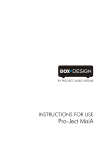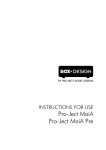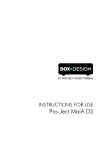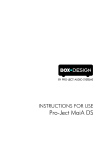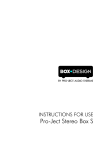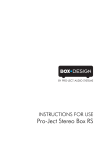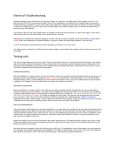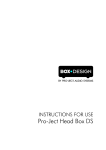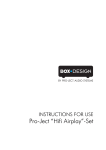Download USER GUIDE - Pro-Ject Audio Systems
Transcript
INSTRUCTIONS FOR USE Pro-Ject MaiA Dear music lover, thank you for purchasing a Pro-Ject Audio Systems´ integrated amplifier. In order to achieve maximum performance and reliability you should study these instructions for use carefully. ! Warning of a hazard for the user, the unit or possible misuse. Important notice. Safety instructions ! AC outlet voltages vary from country to country. Before connecting to the mains, make sure that the voltage in your area meets the voltage requirements printed on the power supply. The power supply is used to connect/disconnect the unit from the mains. Make sure that the power supply is easily accessible at all times. Never handle the device, the power supply while your hands are wet or damp. Avoid letting liquids enter the device or the power supply. Never place any item containing liquid, such as a flower vase on or near the device. Never spill any liquid on the device or the power supply. Never place any naked flame sources, such as lighted candles on or near the device. The product shall not be used in damp or wet locations, next to a bathtub, sink, swimming pool or any other similar conditions. Connectors ! Make all connections except the connection to the headphone whilst the amplifier is disconnected from the power supply. Take care to connect the left and right channels correctly. The right channel is usually marked red, the left channel black or white. Never use any other power supply than the one supplied with the unit. Line output A power amplifier or active loudspeakers can be connected to the output socket marked Output. Phono input Connect the tonearm signal lead to the In 1 Phono of the amplifier. The earthing wire may be connected to the screw terminal if you encounter hum problems when using the turntable. Line inputs Line level sources such as CD player, radio or TV can be connected to the input sockets marked In 2, In 3 or In 4. Digital inputs Sources with a digital output such as TV satellite/cable receiver or a game console can be connected to the digital inputs. Coaxial to In 5 and optical to In 6 and In 7. 2 © Project Audio Systems · Pro-Ject MaiA · Revision 2014.7.8 Connecting to a Computer Connect the USB-input In 8 USB of the MaiA (unit must be switched on) to a free USB-socket on your computer and turn it on/make sure it is powered on. Select input 8 USB. * For Windows® operating systems an USB driver (supplied on CD) has to be installed. Mac OS® operating systems do not need an additional driver. Please note: Connection should be made to an USB-socket of your computer directly. Connecting to USB-hubs or switches can cause problems. 24Bit/192kHz playback with Windows® operating systems * For Windows® operating systems a 24Bit/192kHz USB driver (supplied on CD) has to be installed. Insert the included CD into the drive of you PC and follow the instructions. After installing the driver, some settings have to be checked/done. For example - Windows 7® operating system: Control Panel Hardware and Sound Sound Playback: select Speaker/ MaiA USB 2.0 Audio Out Properties Supported formats: make sure nothing is assigned Level Sound: setting must be 100 Enhancements: disable all enhancements Advanced Default Format: set to studio quality 24/192 Mains power connection Connect the low voltage plug from the power supply to the Power socket before connecting the power supply to the mains. Connection to the speakers The output terminals accept loudspeaker cables terminated with 4mm Banana plugs, spades connectors or naked wire. © Project Audio Systems · Pro-Ject MaiA · Revision 2014.7.8 3 Remote control 1 ON/OFF ON/OFF 0 CH+ 0 0 VOL + VOL VOL+ VOL- turns the unit on or back into standby and 0 adjust the sound volume CH + CH and select the inputs CH- Front panel controls To switch on from standby or to standby The push button on the left side of the front panel turns the unit on or back into standby (press and hold to switch into standby mode). The blue LED above the stand-by push button shows that the unit is switched on. Input selector After the unit is powered on, pressing the buttons ◄ and desired input. ► next to the LEDs inputs indicators selects Volume Adjust the volume to the desired level, using the large knob on the front panel. Connecting a headphone Connect the headphones to the ¼“ (6,3mm ) jack socket on the front of the unit. Bluetooth connection Make sure the antenna is attached to its connector In 9 BT on the back panel prior using bluetooth. Bluetooth is active only once input 9 is selected. Pairing with Android devices Open Settings and tap on Bluetooth. Turn on Bluetooth and tap on Scan. Searched devices will show up. Tap on "MaiA" (Enter "0000" if requested) and confirm by pressing power button on MaiA once the blue LED of the input 9 is fast blinking. Once paired it will show "Connected to media Audio", now you can play music from your Android device over Bluetooth to MaiA. 4 © Project Audio Systems · Pro-Ject MaiA · Revision 2014.7.8 Pairing with Apple devices Tap on Settings, tap on Bluetooth, turn on Bluetooth, your device will automatically start searching for available devices. Tap on "MaiA" and confirm by pressing power button on MaiA once the blue LED of the input 9 is fast blinking. ! MaiA can store up to 8 Bluetooth devices. If the memory is full then it is not possible to pair another device. For erasing the memory turn off the unit > disconnect power supply > press and hold power button > connect power supply > hold power button for 5 seconds > release power button. The blue LED above the power button will blink for few seconds. Once the LED stops blinking, memory is erased and you can turn on the unit. Replacing batteries Proceed as follows: Unlock and slide open the battery case cover Replace the battery. Make sure the battery is the right way round ! Close the battery case cover Battery type: 1 x CR2032 / 3V or 1 x CR2025 / 3V Do not dispose the batteries as ordinary domestic refuse. Please dispose your exhausted batteries at the appropriate collection sites - usually located at supermarkets and drugstores. Technical specifications Pro-Ject MaiA Power output : Frequency response : Channel separation : Noise floor : THD : Gain : Line level inputs : Line input sensitivity : Line input impedance : Phono input : Phono input sensitivity : Phono input impedance : Phono input gain : S/PDIF coaxial input : S/PDIF optical input : USB input : USB data transfer : Digital to Analogue converter : Variable line level output : Bluetooth music receiver codec : Bluetooth range : Speakers connectors: Outboard power supply : Power consumption : Replacement battery remote control : Dimensions W x H x D (D with sockets) : Weight : 2x 25W/37W at 8 ohms/4 ohms (both channels driven) 20Hz - 20kHz (-0,3dB, -2,5dB) > 65dB at 20kHz > -90dB (A weighted) < 0,07% at 15W 31dB (measured via line level input) 2 pair RCA + 1 jack 3.5mm 350mV 50kohms 1 pair RCA suitable for MM, MI or high output MC cartridges 47kohms 40dB up to 24bit and 192kHz up to 24bit and 96kHz USB Audio Class 2 requires USB 2.0 or higher on computer Asynchronous Cirrus Logic CS4344 24bit/192kHz Multi-bit Delta Sigma type jack 3.5mm aptX, A2DP profile 10 meters in direct visibility between source and receiver 4mm banana plugs, spades connectors or naked wire 20V/3A DC, suitable for your country's mains supply max. 3A DC, <0.5W in standby 1 x CR2032 / 3V or 1 x CR2025 / 3V 206 x 36 x 150 (165)mm 1250 g without power supply © Project Audio Systems · Pro-Ject MaiA · Revision 2014.7.8 5 Service Should you encounter a problem which you are not able to alleviate or identify, please contact your dealer for further advice. Only if the problem cannot be resolved there, the unit should be sent to the responsible distributor in your country. Warranty The manufacturer accepts no responsibility for damage caused by not adhering to these instructions for use. Modification or changes to any part of the product by unauthorized persons release the manufacturer from any liability over and above the lawful rights of the customer. Copyright, trademarks Pro-Ject Audio Systems is a registered Trademark of H. Lichtenegger. This guide was produced by: Pro-Ject Audio Systems Copyright © 2014. All rights reserved. 6 The information was correct at the time of going to press. The manufacturer reserves the right to make changes to the technical specification without prior notice as deemed necessary to uphold the ongoing process of technical development. © Project Audio Systems · Pro-Ject MaiA · Revision 2014.7.8






